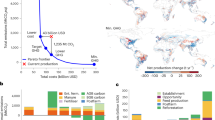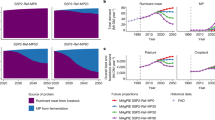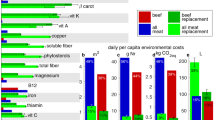Abstract
Food production dominates land, water and fertilizer use and is a greenhouse gas source. In the United States, beef production is the main agricultural resource user overall, as well as per kcal or g of protein. Here, we offer a possible, non-unique, definition of ‘sustainable’ beef as that subsisting exclusively on grass and by-products, and quantify its expected US production as a function of pastureland use. Assuming today’s pastureland characteristics, all of the pastureland that US beef currently use can sustainably deliver ≈45% of current production. Rewilding this pastureland’s less productive half (≈135 million ha) can still deliver ≈43% of current beef production. In all considered scenarios, the ≈32 million ha of high-quality cropland that beef currently use are reallocated for plant-based food production. These plant items deliver 2- to 20-fold more calories and protein than the replaced beef and increase the delivery of protective nutrients, but deliver no B12. Increased deployment of rapid rotational grazing or grassland multi-purposing may increase beef production capacity.
This is a preview of subscription content, access via your institution
Access options
Access Nature and 54 other Nature Portfolio journals
Get Nature+, our best-value online-access subscription
$29.99 / 30 days
cancel any time
Subscribe to this journal
Receive 12 digital issues and online access to articles
$119.00 per year
only $9.92 per issue
Buy this article
- Purchase on Springer Link
- Instant access to full article PDF
Prices may be subject to local taxes which are calculated during checkout




Similar content being viewed by others
References
Eshel, G., Shepon, A., Noor, E. & Milo, R. Environmentally optimal, nutritionally aware beef replacement plant-based diets. Environ. Sci. Technol. 50, 8164–8168 (2016).
Ranganathan, J. et al. Shifting Diets for a Sustainable Food Future (World Resources Institute, 2016); http://www.b4fn.org/resources/publications/publication/shifting-diets-for-a-sustainable-food-future/.
Eshel, G., Shepon, A., Makov, T. & Milo, R. Partitioning United States’ feed consumption among livestock categories for improved environmental cost assessments. J. Agric. Sci. 153, 432–445 (2014).
Eshel, G., Shepon, A., Makov, T. & Milo, R. Land, irrigation water, greenhouse gas and reactive nitrogen burdens of meat, eggs and dairy production in the United States. Proc. Natl Acad. Sci. USA 111, 11996–12001 (2014).
Clark, M. & Tilman, D. Comparative analysis of environmental impacts of agricultural production systems, agricultural input efficiency, and food choice. Environ. Res. Lett. 12, 64016 (2017).
Nickerson, C. & Borchers, A. How is Land Used (United States Department of Agriculture Economic Research Service, 2012); https://www.ers.usda.gov/amber-waves/2012/march/data-feature-how-is-land-used/.
Doering, O. C., Galloway, J. N., Theis, T. I. & Swackhamer, D. I. Reactive Nitrogen in the United States: An Analysis of Inputs, Flows, Consequences and Management Options: A Report of the EPA Science Advisory Board (United States Environmental Protection Agency, 2011); https://yosemite.epa.gov/sab/sabproduct.nsf/0/67057225CC780623852578F10059533D/$File/EPA-SAB-11-013-unsigned.pdf.
Maupin, M. A. et al. Estimated Use of Water in the United States in 2010 Circular 1405 (USGS, 2010).
Inventory of U.S. Greenhouse Gas Emissions and Sinks: 1990–2013 (United States Environmental Protection Agency, 2015).
Willett, W. C. & Skerrett, P. J. Eat, Drink, and Be Healthy: The Harvard Medical School Guide to Healthy Eating (Simon & Schuster Source, New York, 2005).
Heller, M. C., Keoleian, G. A. & Willett, W. C. Toward a life cycle-based, diet-level framework for food environmental impact and nutritional quality assessment: a critical review. Environ. Sci. Technol. 47, 12632–12647 (2013).
Jahn, J. L., Stampfer, M. J. & Willett, W. C. Food, health & the environment: a global grand challenge & some solutions. Daedalus 144, 31–44 (2015).
Machmuller, M. B. et al. Emerging land use practices rapidly increase soil organic matter. Nat. Commun. 6, 6995 (2015).
Braun, A., van Dijk, S., Del Rio Paracolls, C. & Grulke, M. Upscaling Silvopastoral Systems in South America (Inter-American Development Bank, 2016).
Garnett, T. Livestock-related greenhouse gas emissions: impacts and options for policy makers. Environ. Sci. Policy 12, 491–503 (2009).
Tichenor, N. E., Peters, C. J., Norris, G. A., Thoma, G. & Griffin, T. S. Life cycle environmental consequences of grass-fed and dairy beef production systems in the northeastern United States. J. Clean. Prod. 142, 1619–1628 (2017).
Estes, J. A. et al. Trophic downgrading of planet Earth. Science 333, 301–306 (2011).
Pelletier, N., Pirog, R. & Rasmussen, R. Comparative life cycle environmental impacts of three beef production strategies in the upper midwestern United States. Agric. Syst. 103, 380–389 (2010).
Entz, M. H. et al. Potential of forages to diversify cropping systems in the Northern Great Plains. Agron. J. 94, 240–250 (2002).
Hu, Z. et al. A synthesis of the effect of grazing exclusion on carbon dynamics in grasslands in China. Glob. Change Biol. 22, 1385–1393 (2016).
Pierrehumbert, R. T. & Eshel, G. Climate impact of beef: an analysis considering multiple time scales and production methods without use of global warming potentials. Environ. Res. Lett. 10, 85002 (2015).
Daley, C. A., Abbott, A., Doyle, P. S., Nader, G. A. & Larson, S. A review of fatty acid profiles and antioxidant content in grass-fed and grain-fed beef. Nutr. J. 9, 10 (2010).
Shepon, A., Eshel, G., Noor, E. & Milo, R. Energy and protein feed-to-food conversion efficiencies in the US and potential food security gains from dietary changes. Environ. Res. Lett. 11, 105002 (2016).
Yang, Q. et al. Added sugar intake and cardiovascular diseases mortality among US adults. JAMA Intern. Med. 174, 516–524 (2014).
Craig, W. J. & Mangels, A. R. Position of the American Dietetic Association: vegetarian diets. J. Am. Diet. Assoc. 109, 1266–1282 (2009).
Tuso, P., Stoll, S. R. & Li, W. W. A plant-based diet, atherogenesis, and coronary artery disease prevention. Perm. J. 19, 62–67 (2015).
Li, Y. et al. Saturated fats compared with unsaturated fats and sources of carbohydrates in relation to risk of coronary heart disease. J. Am. Coll. Cardiol. 66, 1538–1548 (2015).
Pan, A. et al. Red meat consumption and mortality: results from 2 prospective cohort studies. Arch. Intern. Med. 172, 555–563 (2012).
Hu, F. B. Plant-based foods and prevention of cardiovascular disease: an overview. Am. J. Clin. Nutr. 78, 544S–551S (2003).
Eshel, G. A geophysical foundation for alternative farm policy. Environ. Sci. Technol. 44, 3651–3655 (2010).
Satija, A. et al. Plant-based dietary patterns and incidence of type 2 diabetes in US men and women: results from three prospective cohort studies. PLoS Med. 13, e1002039 (2016).
Alfaia, C. P. M. et al. Effect of the feeding system on intramuscular fatty acids and conjugated linoleic acid isomers of beef cattle, with emphasis on their nutritional value and discriminatory ability. Food Chem. 114, 939–946 (2009).
Röös, E., Patel, M., Spångberg, J., Carlsson, G. & Rydhmer, L. Limiting livestock production to pasture and by-products in a search for sustainable diets. Food Policy 58, 1–13 (2016).
Peters, C. J. et al. Carrying capacity of U.S. agricultural land: ten diet scenarios. Elem. Sci. Anthr. 4, 116 (2016).
Hannaway, D. B., Ballerstedt, P. J. & Fribourg, H. A. Country Profiles - The United States (FAO, 2011).
Acknowledgements
R.M. and E.S. are supported by the European Research Council (project NOVCARBFIX 646827); the Israel Science Foundation (grant no. 740/16); Beck-Canadian Center for Alternative Energy Research; Dana and Yossie Hollander; R.M. holds the Charles and Louise Gartner professional chair.
Author information
Authors and Affiliations
Contributions
G.E., A.S., R.M., S.G., D.G. and M.E.R. initiated the study. G.E. compiled the data, conducted all analyses, produced the graphics and wrote the paper. R.M. edited an initial draft. G.E., A.S., T.S., B.D.C., S.G., D.G., M.E.R. and R.M. edited and commented on subsequent drafts and discussed the results.
Corresponding authors
Ethics declarations
Competing interests
The authors declare no competing interests.
Additional information
Publisher’s note: Springer Nature remains neutral with regard to jurisdictional claims in published maps and institutional affiliations.
Supplementary information
Supplementary information
Supplementary models, figures and references.
Rights and permissions
About this article
Cite this article
Eshel, G., Shepon, A., Shaket, T. et al. A model for ‘sustainable’ US beef production. Nat Ecol Evol 2, 81–85 (2018). https://doi.org/10.1038/s41559-017-0390-5
Received:
Accepted:
Published:
Issue Date:
DOI: https://doi.org/10.1038/s41559-017-0390-5
This article is cited by
-
Supplying ecosystem services on US rangelands
Nature Sustainability (2023)
-
Low-opportunity-cost feed can reduce land-use-related environmental impacts by about one-third in China
Nature Food (2023)
-
Economic estimation of Bitcoin mining’s climate damages demonstrates closer resemblance to digital crude than digital gold
Scientific Reports (2022)
-
Nutrient provision capacity of alternative livestock farming systems per area of arable farmland required
Scientific Reports (2021)
-
Challenges for scaling up conservation
Nature Sustainability (2018)



